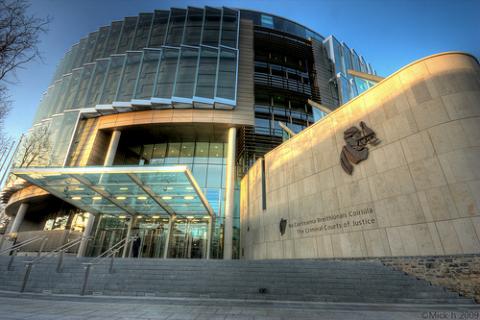The law parades its privilege in lavish new home

Who decided that such a large amount of public money should be spent on the construction of this 'statement building'? By Vincent Browne.
Members of the Bar are delighted with the new Criminal Courts of Justice building on Parkgate Street.
State-of-the-art and all that. The courts needed additional accommodation and, had existing facilities been refurbished and extended, the cost would have been only €24m less than the new building cost.
So why not?
After all, there would be savings in terms of Garda time, the leasing of space in the Kings Inns, and the Distillery Building in Church Street, which is owned by the Bar Council. Also, the building in Smithfield, where the Children’s Court is, could be sold off.
It would also allow for greater efficiency in the Courts Service - and we are all for efficiency nowadays.
Unfortunately, the Courts Service didn’t even bother to do estimates of the time that would be saved by the new facilities.
But let’s not get pernickety over a state-of-the-art construction. Pat Rabbitte said it was ‘‘the outstanding statement building of the boom’’, whatever a statement building is.
Officials from the Courts Service were before the joint Oireachtas Committee of Public Accounts ten days ago, to be quizzed about the cost of the building, the role of tipstaffs and other court services.
Tipstaffs are the gentlemen (no women as far as I know) who precede judges on their way through the halls of the courts, tipping the ground before them to alert the populace to make way for their ‘‘Excellencies’’ as they proceed to their benches in their wigs and robes.
More about tipstaffs in a moment.
The new courts building came about via a public-private partnership (PPP), whereby private capital is deployed to build public infrastructure, in return for an agreed payback.
Savings of €22m were projected arising from property disposal and reduced operating costs, including costs associated with the transportation of prisoners. Some €10m of the savings were expected to come from the sale of the Children’s Court building.
Unhappily, that has not happened, and is not now likely to happen for quite some time because of the property price collapse. Nor is there any figure available for savings on transportation costs.
In a statement issued on the opening of the Criminal Courts of Justice on November 23 last year, it was stated that the total cost of designing, building, maintaining the complex, plus providing support facilities over the 28-year period of the contract, was €291m net, in present money terms.
At the committee hearings the chief executive of the Courts Service, Brendan Ryan, said the construction and fit out costs were €149m, including Vat. He added that there would also be a ‘‘€21.4m unitary charge for 25 years’’ ,which amounts to €535m.
Anyway, this ‘‘statement building’’ either did cost or will cost a very large amount of money - and the question I want to ask is: who decided that such a large amount of public monies should be spent on this PPP venture rather than, say, on the regeneration of St Michael’s estate in Inchicore, which is only a few stones’ throws away?
According to the St Michael’s website, the project was to provide for the physical and social regeneration of the estate, involving 720 dwellings (165 social, 75 affordable, 480 private). It would also have included a civic centre with a library, a parish centre, three creches, a youth centre, a family resource centre, a healthcare centre, two football pitches, play areas, a new urban square, a village green and a public square.
This was all abandoned in 2008, while the new Criminal Courts of Justice statement building was under construction.
How could it be that a courts building, an upgrade of existing facilities, got priority at such enormous cost, ahead of housing for thousands of people in a disadvantaged area? It makes no sense, but perhaps every bit as much sense as the tipstaff carry-on.
There are 82 tipstaffs employed by the Courts Service. They act as personal valets to the judges of the Supreme, High and Circuit courts.
Brendan Ryan told the committee: ‘‘Tipstaffs perform an essential service in that they are the only link the judge has with the legal profession, the Courts Service, and the outside world.”
It would seem from that remark that judges don’t have telephones or, if they do, they don’t know how to operate them without the assistance of tipstaffs!
Actually, I met a senior judge the other day at a funeral, and it took him a considerable amount of time to find out what his mobile phone number was. I was surprised to discover later that day that he was able to send a text, admittedly one of only three letters.
Aside from tipstaffs, judges on circuit are given an allowance for a sitting room. This is separate from the allowance they get for bed, breakfast, lunch and dinner. They also get an allowance for having a library at their home.
Bernard Allen, chairman of the Committee of Public Accounts, remarked unkindly: ‘‘This strikes me as akin to the moat allowance in the House of Commons.”
It is all quite crackers.
